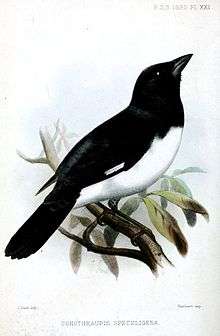Black-and-white tanager
| Black-and-white tanager | |
|---|---|
 | |
| Scientific classification | |
| Kingdom: | Animalia |
| Phylum: | Chordata |
| Class: | Aves |
| Order: | Passeriformes |
| Family: | Thraupidae |
| Genus: | Conothraupis |
| Species: | C. speculigera |
| Binomial name | |
| Conothraupis speculigera (Gould, 1855) | |
The black-and-white tanager (Conothraupis speculigera) is a tanager found in Bolivia, Ecuador, Peru and the Brazilian state of Acre. The only other member of its genus is the recently rediscovered cone-billed tanager.
It has a total length of 16 cm. (6½ in) and weighs 23–28 g. (0,8-1 oz). The male is black with a grey rump, white underparts and a white wing-speculum. It is longer-billed than the superficially similar black-and-white seedeater and lacks the black flanks and chalk-white bill of the related cone-billed tanager. The female is olive with faintly mottled, yellow-tinged underparts. Both sexes have a reddish iris and a greyish bill.
The males' song is distinctive, blackbird-like, loud and ringing.
This bird is found in scrub, woodland and forest borders at elevation of 100–1800 m. (330–5900 ft). It is generally uncommon to rare and usually seen singly or in pairs, but may be found in flocks of up to 50 individuals. It eats insects and seeds. In the northern part of its range it breeds during the rainy season (around March), after which it disperses.
The nest was only described in 2006. It is open and rather untidy and loosely woven, some 6–7 cm high and 10–11 cm wide outside, with a nest cup some 6 cm wide and 4 cm deep. It is placed at medium height (about 50–150 cm above ground) in small shrubs.[2] It is built from sticks and leaf petioles, and lined with black rhizomorphs of fungi.[3]
The clutch presumably consists of 2-3 eggs. These are pale blue with heavy, quite evenly distributed brown blotching and measure c.21 by 15.6 mm.[3]
Footnotes
- ↑ BirdLife International (2012). "Conothraupis speculigera". IUCN Red List of Threatened Species. Version 2013.2. International Union for Conservation of Nature. Retrieved 26 November 2013.
- ↑ E.g. Urticaceae or Lantana sp.; maybe such thorny or bristly species are preferred. See Greeney et al. (2006).
- 1 2 Greeney et al. (2006)
References
- Clements, James F.; Shany, Noam; Gardner, Dana & Barnes, Eustace (2001): A Field Guide to the Birds of Peru. Ibis, Temecula, CA. ISBN 0-934797-18-8
- Greeney, Harold F.; Juiña, Mery & Fernando Sornoza, A. (2006): Nest descriptions for Conothraupis speculigera and Thlypopsis ornata in Ecuador. Boletín de la Sociedad Antioqueña de Ornitología 16(1): 24-29. [English with Spanish abstract] PDF fulltext
- Ridgely, Robert S & Greenfield, Paul J. (2001): The Birds of Ecuador. Comstock, Ithaca, NY. ISBN 0-8014-8721-8
- Ridgely, Robert S.; Tudor, Guy & Brown, William L. (1989): The Birds of South America Volume 1: The oscine passerines. University of Texas Press, Austin. ISBN 0-19-857217-4
